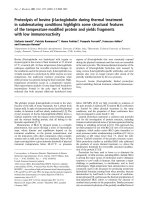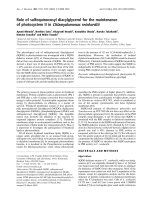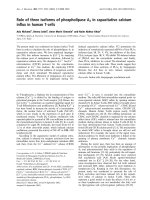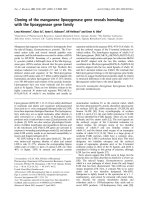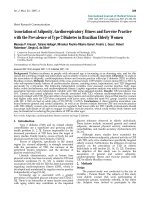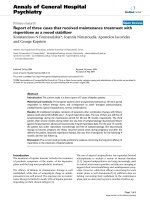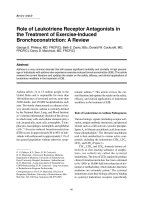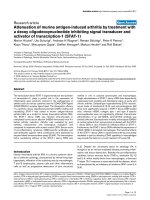Báo cáo y học: "Report of three cases that received maintenance treatment with risperidone as a mood stabilizer" ppsx
Bạn đang xem bản rút gọn của tài liệu. Xem và tải ngay bản đầy đủ của tài liệu tại đây (201.02 KB, 4 trang )
BioMed Central
Page 1 of 4
(page number not for citation purposes)
Annals of General Hospital
Psychiatry
Open Access
Primary research
Report of three cases that received maintenance treatment with
risperidone as a mood stabilizer
Konstantinos N Fountoulakis*, Ioannis Nimatoudis, Apostolos Iacovides
and George Kaprinis
Address: 3rd Department of Psychiatry, Aristotle University of Thessaloniki, Greece
Email: Konstantinos N Fountoulakis* - ; Ioannis Nimatoudis - ;
Apostolos Iacovides - ; George Kaprinis -
* Corresponding author
Abstract
Introduction: The current study is a short report of 3 cases of bipolar patients.
Material and methods: Three bipolar patients were prospectively followed up. All were partial
responders to lithium therapy alone, and unresponsive to other therapies (anticonvulsants,
antidepressants, typical antipsychotics, various combinations).
Results: All manifested complete remission of symptoms after combination therapy with lithium
(plasma levels above 0.8 mEq/lt) plus 1–3 mg of risperidone daily. The two of them are still free of
symptomatology during the maintenance period for 28 and 38 months respectively. The third
patient, after several months during which she was free of symptomatology discontinued lithium
against the psychiatrist's advise and received only 3 mg of risperidone daily. For the next 15 months
the patient was under risperidone monotherapy and free of symptomatology. She discontinued
therapy to become pregnant, the illness recurred several times during pregnancy and after the
delivery the patient restarted risperidone therapy. She was free of symptoms for the following 9
months until her last follow-up.
Discussion: The current study provides preliminary evidence concerning the long term efficacy of
risperidone in the treatment of bipolar patients
Introduction
The treatment of bipolar disorder includes the treatment
of psychotic symptoms, of the manic, of the depressive
phase and the long-term prophylactic treatment.
The efficacy of lithium in maintenance therapy is well
established, while that of antiepileptic drugs or antide-
pressants is less well proved. The response rate to mainte-
nance therapy is limited to nearly 50% of bipolar patients,
depending on their clinical subtype [1].
The use of atypical antipsychotics has expanded beyond
schizophrenia to include a variety of mental disorders
[2,3]. Atypical antipsychotics are being increasingly used
to control acute manic episodes, and data are emerging to
support their mood-stabilizing and antidepressant prop-
erties. However, while their efficacy concerning the acute
manic phase is well documented [4], sufficient data are
lacking concerning their usefulness in the maintenance
phase and no data exist beyond 6 months of follow-up.
Published: 26 May 2004
Annals of General Hospital Psychiatry 2004, 3:10
Received: 26 January 2004
Accepted: 26 May 2004
This article is available from: />© 2004 Fountoulakis et al; licensee BioMed Central Ltd. This is an Open Access article: verbatim copying and redistribution of this article are permitted in
all media for any purpose, provided this notice is preserved along with the article's original URL.
Annals of General Hospital Psychiatry 2004, 3 />Page 2 of 4
(page number not for citation purposes)
The current study reports three cases of refractory bipolar
I patients with a follow up of 28, 38 and 15 plus 9
months. Two of them received risperidone as adjunctive
therapy to lithium and one as monotherapy. To our
knowledge these are the longest reported follow-up cases
in the literature.
They were the first ones recruited by the authors in the
frame of a larger study. No selection bias concerning their
(beneficial) response to treatment is present, and they
underwent a full laboratory investigation including blood
and biochemical tests and EEG.
Case 1
The patient is a 31 years old unmarried bipolar I female.
At the age of 20 she manifested a manic episode with
auditory hallucinations, about 1 month duration. Five
more manic episodes followed, with a seasonal pattern
(spring). Depressive episodes followed manic ones (ratio
1:1) and the patient reported that she continuously felt
depressed with only manic episodes braking depression.
During the first assessment (April 13, 2000), the patient
had severe depression, and was under 600 mg lithium
(0.6 mEq/lt), 3 mg Risperidone, 60 mg mianserin and 225
mg clomipramine per os daily. Response to treatment was
unsatisfactory. She was put on 900 mg lithium (Lithio-
for), 1 mg Risperidone and 60 mg mianserin per os daily.
Serum lithium levels rose to 1.00 mEq/lt by April 29,
2000 response to treatment was compete.
During the next few months, the patient was free of symp-
tomatology, although she reported mild subclinical 'mis-
ery'. She was unable to return to normal functioning.
Lithium was gradually discontinued and topiramate was
gradually titrated up to 400 mg per day. She also contin-
ued to receive 1 mg risperidone and 150 mg clomi-
pramine per os daily was also added. By November 25,
2000 the patient reported complete recovery and lost 15
kilograms.
From December 18, 2000 to January 16, 2001 the patient
manifested a manic episode and got hospitalized. During
her hospitalization she was treated with the combination
of haloperidol 5 mg, plus chlorpromazine HCl 25 mg,
and biperiden 5 mg i.m. The episode remitted completely
and the patient was released. She was put to lithium 1200
mg (0.9 mEq/lt) and Risperidone 1 mg per os daily.
Since then the patient was stable until her most recent fol-
low-up (April 5
th
, 2004), that is for 38 months. There are
mild periods of 'misery' and 'happiness' that cannot be
considered as clinically significant and remit spontane-
ously.
Conclusively, the patient achieved maximum response
under lithium 1200 mg (0.9 mEq/lt) and Risperidone 1
mg per os daily, but this maximum response took several
months to appear.
Case 2
The patient is a 25 years old unmarried bipolar I female
patient with psychotic features, student of Architecture. At
the age of 16 she experienced a psychotic-like episode. She
was agitated, verbally and physically aggressive and had
the delusional belief that her father was planning to kill
her. She had neither hallucinations, nor euphoric mood.
She was treated with haloperidol. The episode lasted for
about 1.5 months. No maintenance treatment was pre-
scribed.
At the age of 19 while facing important exams at school
she developed severe depression. The episode remitted
without treatment within weeks. Six months later she
developed a typical manic episode. She received lithium
(0.5–0.6 mEq/lt). and risperidone and the duration was 2
months.
The patient was reluctant to follow the prescribed treat-
ment and many times refused to take the medication.
Soon she discontinued treatment completely.
Since then she suffered from recurrent episodes of mania
lasting 1–2 months followed by depression which was
lasting for several months. The rate was 1:1 and both
phases were appearing once per year. She was prescribed
with carbamazepine, lithium (0.5–0.6 mEq/lt), oxcar-
bazepine and fluvoxamine with poor results. In spite of
these difficulties she managed to enter the School of
Architecture at the University.
The patient was first assessed in August 28, 2001 and
reported unremitted depression for the past 8 months.
She had given up her studies at the University. The patient
was put under lithium (900 mg) plus risperidone 1 mg
per os daily.
An important element of her medical file was a history of
hyperprolactemia (successfully treated) and polycystic
ovaries. By September 13, 2001 the patient's condition
was unchanged but lithium level was 0.6 mEq/lt. Lithium
increased to 1200 mg per os daily.
In October 4, 2001, the patient reported that she felt
much better and she has returned to her studies. Her lith-
ium level was 0.8 mEq/lt and serum prolactin levels were
408 µU/ml (within the normal range). By November 12,
2001 the patient reported that her illness was in full
remission. There was only a slight fatigue and concentra-
tion difficulty left.
Annals of General Hospital Psychiatry 2004, 3 />Page 3 of 4
(page number not for citation purposes)
The patient was stable until the most recent follow-up
(April 4th, 2004) that is for about 28 months.
Case 3
The patient is a 35 years old married bipolar I female
patient with psychotic features.
At the age of 23 (August 12, 1991) she was hospitalized
because of persecutory delusions without hallucinations.
In the next couple of months two more similar episodes
occurred and all lasted less than two weeks each. During
this period she received various agents including haloperi-
dol, thioridazine, chlorpromazine, sulpiride and others.
From 1991 to 1995 she was under psychoanalytically ori-
ented psychotherapy and suffered from one more epi-
sode. In 1991 she graduated from University and soon
after she started another course of studies. In summer
1995 she was caught cheating at the examinations at the
University and a new similar episode occurred. However,
after this episode, she manifested mood liability. Car-
bamazepine treatment was tried but discontinued because
of adverse effects. Her mood became depressed, she was
feeling fatigue, loss of interest, despair and deep pessi-
mism. Medication changed to imipramine 75 mg and
alprazolam 2 mg per os daily. Soon the symptoms par-
tially remitted and the patient was released.
In 1996 she graduated from the Kindergarten Teachers'
School.
In January 1997 she manifested a depressive episode. Her
prolactin plasma levels were 2375 µU/ml (normal values
below 600 µU/Lt). Soon afterwards she manifested rapid
shifts of mood from hyperthymic-agitated to depressed.
Spontaneous remission occurred two weeks later.
During the following year, the patient suffered from
chronic mild depression. She was put on 1200 mg lithium
(0.90–1.00 mEq/lt). Response was unsatisfactory.
Three months latter she was hospitalised again, because of
a mild manic episode. Risperidone 2 mg per os daily was
added. The patient manifested almost complete remission
of symptoms one month later. The medication remained
unchanged during the maintenance phase.
A year latter, still in full remission she got married. A few
months latter she was appointed as a teacher at a high
school and started working full time, on a regular basis.
After a year the patient discontinued any medication in an
effort to stay pregnant. Soon afterwards a new manic epi-
sode appeared. After restarting medication, she responded
within one week.
In January 15, 2000 the patient was readmitted to the hos-
pital suffering from severe anxiety and restlessness. How-
ever no overt psychotic or manic symptomatology was
present. She recovered completely within less than one
week. However her prolactin levels were high again
(>2000 µU/Ll) and the patient also suffered from amen-
orrhoea (the rest of hormonal investigation and brain
MRI were normal). Risperidone was substituted by olan-
zapine first and then by quetiapine, but both agents were
discontinued because of adverse effects. The patient
demanded to return to risperidone.
While being free of symptomatology, in June, 2001, and
against the advice of her therapist, the patient gradually
stopped taking lithium. She refused to continue receiving
it because she felt that it caused sedation. He accepted to
receive only 3 mg of risperidone daily.
Since then she was on risperidone monotherapy. She
reported that her mind was clear, she was able to concen-
trate and felt that this is the most suitable therapy for her.
No side effects were evident and her quality of life was the
best in the last ten years.
Since then the patient had been stable until the follow-up
visit of October 10
th
, 2002, for a total period of 18
months, and for 15 of them she was under risperidone
monotherapy. Then the patient decided to discontinue
medication in order to become pregnant (again against
her therapist's advise). In the following months, she suf-
fered from several but brief and mild manic episodes, but
managed to become pregnant. She firmly refused to
receive any kind of medication and along with her hus-
band decided to keep the baby. She suffered from a fur-
ther series of similar manic episodes and was hospitalized
several times until the delivery, in July 2003. Then the
patient started receiving 2 mg Risperidone daily and was
free of symptoms since her last follow up in April 1
st
,
2004, that is for 9 months.
Discussion
Atypical antipsychotics and especially risperidone block
5-HT2 receptors which lead to an increase of dopamine
activity in the frontal cortex, and thus they manifest anti-
depressant activity, while simultaneously they block D2
activity in the mesolimbic system and thus manifesting an
antimanic effect. The biochemical profile of risperidone
suggests that it could serve as a mood stabilizer, prevent-
ing both manic and depressive phases of bipolar illness
[5].
Double-blind and open-label studies support the useful-
ness of risperidone either alone or in combination with
mood stabilizers in treating acute mania by [6]. Addition-
ally it is suggested that approximately 20% more patients
Publish with BioMed Central and every
scientist can read your work free of charge
"BioMed Central will be the most significant development for
disseminating the results of biomedical research in our lifetime."
Sir Paul Nurse, Cancer Research UK
Your research papers will be:
available free of charge to the entire biomedical community
peer reviewed and published immediately upon acceptance
cited in PubMed and archived on PubMed Central
yours — you keep the copyright
Submit your manuscript here:
/>BioMedcentral
Annals of General Hospital Psychiatry 2004, 3 />Page 4 of 4
(page number not for citation purposes)
respond by week 3 to the combination in comparison to
a mood stabilizer alone [7].
However, all these studies concern acute treatment. The
longest study concerning risperidone is a six-month open
study [8]. Data concerning longer periods of time and
maintenance treatment are lacking.
The current paper reports three cases of refractory bipolar
I patients successfully treated with a combination of lith-
ium and risperidone or risperidone alone, and followed-
up for 28, 38 and 15 plus 9 months, which is the longest
reported follow-up period in the literature utill now.
Until today, only olanzapine has received official
approval as monotherapy for the maintenance phase of
bipolar illness. Our data suggest that further research is
necessary to investigate the long term efficacy of the other
atypical antipsychotics as mood stabilizers.
Conflict of interest
All authors have received funding by Janssen Pharmaceu-
ticals which is the manufacturer of Risperdal (risperi-
done), Eli Lilly, Sanofi-Synthelabo and AstraZeneca to
attend several conferences.
References
1. Soares JC: Recent advances in the treatment of bipolar mania,
depression, mixed states and rapid cycling. International Clinical
Psychopharmacology 2000, 15:183-196.
2. Fountoulakis KN, O'Hara R, Iacovides A, Camilleri CP, Kaprinis S,
Kaprinis G, Yesavage J: Unipolar late-onset depression: A com-
prehensive review. Ann Gen Hosp Psychiatry 2003, 2:11.
3. Reichman WE: Current pharmacologic options for patients
with Alzheimer's disease. Ann Gen Hosp Psychiatry 2003, 2:1.
4. DelBello MP, Schwiers ML, Rosenberg HL, Strakowski SM: Quetiap-
ine as adjunctive treatment for adolescent mania. 2nd Interna-
tional Forum on Mood and Anxiety Disorders Monte Carlo, Monaco;
2001.
5. Yatham LN: Mood stabilization and the role of antipsychotics.
International Clinical Psychopharmacology 2002, 17:S21-S27.
6. Sachs GS, Grossman F, Ghaemi SN, Okamoto A, Bowden CL: Com-
bination of a mood stabilizer with risperidone or haloperidol
for treatment of acute mania: a double-blind, placebo-con-
trolled comparison of efficacy and safety. American Journal of Psy-
chiatry 2002, 159:1146-1154.
7. Yatham LN: Mood stabilization and the role of antipsychotics.
International Clinical Psychopharmacology 2002, 17:S21-7.
8. Vieta E, Martinez G, Fernandez A, Gasto C: Risperidone treat-
ment of bipolar disorder: findings of a 6-month open label
study in Spain. Archives of General Psychiatry 2000, 59:62-69.

